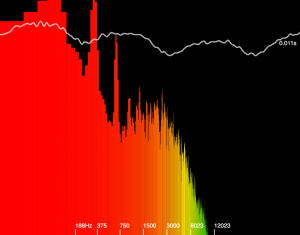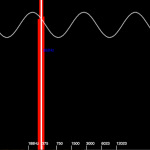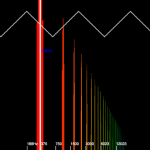
[Sound Analyzer] ← Try it on your own device!
What to do
Use the sound analyzer to see an analysis of your voice. Sound is a wave, a traveling vibration. The strength of that vibration detected by the microphone of the sound analyzer is shown near the top of the screen as a graph of vibrational power on the vertical axis and time on the horizontal axis. Only a fraction of a second is graphed at a time, but this is enough to get an idea of the shape of the wave. Below that is a graph showing the strength of different frequencies of vibration during that same span of time. In this graph, known as a Fourier spectrum, the vertical axis is power and the horizontal axis is frequency in units of Hertz, cycles per second.
Try raising and lowering the pitch of your voice. Also try changing how loud you are. What changes?
Pure Tones

Click on the sound analyzer screen to change input sources. An input source known as a sine wave is called a pure tone. Moving your mouse left and right will change the frequency of the tone.

A Fourier spectrum is produced by mathematically transforming the sound wave into a sum of sine waves. Each sine wave in the sum has a different frequency. This useful mathematical technique originates with Jean-Baptiste Joseph Fourier who discovered it in the early 1800s while studying not sound but heat flows.
In the sound analyzer, the Fourier spectrum of a “pure tone” usually shows multiple nearby frequencies rather than just a single one. That is because the sound analyzer uses a discrete Fourier transform. The precise frequency being generated may not have an exact match in the fixed set of frequencies used by the analyzer, so it comes up with the closest approximation that it can by using multiple nearby frequencies.
Complex Tones

Some of the other input sources in the sound analyzer include triangle and square waves. These shapes, unlike a sine wave, produce a Fourier spectrum with many frequencies. As Fourier discovered, it is possible to produce a wave shape that is not a sine wave by adding together multiple sine waves of different frequencies.